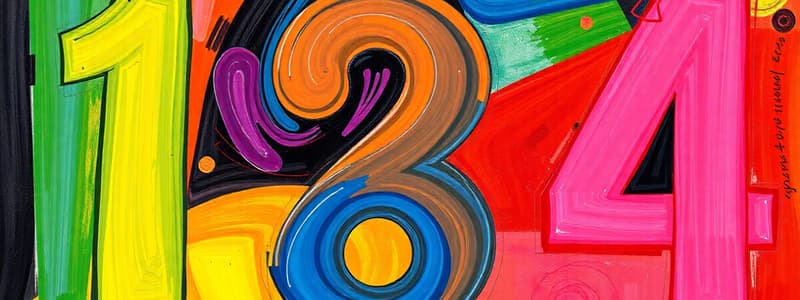Podcast
Questions and Answers
Which property of whole numbers is demonstrated by the equation $5 \times (2 + 3) = (5 \times 2) + (5 \times 3)$?
Which property of whole numbers is demonstrated by the equation $5 \times (2 + 3) = (5 \times 2) + (5 \times 3)$?
- Distributive Property (correct)
- Associative Property
- Commutative Property
- Closure Property
A farmer has 3 fields. Field A has 15 cows, field B has 12 cows, and field C has 8 cows. Using the associative property of addition, which expression demonstrates how the farmer can group the fields to find the total number of cows?
A farmer has 3 fields. Field A has 15 cows, field B has 12 cows, and field C has 8 cows. Using the associative property of addition, which expression demonstrates how the farmer can group the fields to find the total number of cows?
- 15 × (12 + 8) = (15 × 12) + (15 × 8)
- (15 + 12) + 8 = 15 + (12 + 8) (correct)
- 15 + 12 = 12 + 15
- 15 + 12 + 8 = 15 + 8 + 12
A pizza is cut into 8 equal slices. If you take 2 slices and your friend takes 3 slices, what geometric shape are you primarily working with when considering the whole pizza?
A pizza is cut into 8 equal slices. If you take 2 slices and your friend takes 3 slices, what geometric shape are you primarily working with when considering the whole pizza?
- Polygon
- Triangle
- Quadrilateral
- Circle (correct)
Which of the following statements is NOT true regarding whole numbers and the properties that apply to them?
Which of the following statements is NOT true regarding whole numbers and the properties that apply to them?
If a builder is designing a roof with an angle that is greater than 90 degrees but less than 180 degrees, what type of angle is being used?
If a builder is designing a roof with an angle that is greater than 90 degrees but less than 180 degrees, what type of angle is being used?
In a park design, a circular flower bed has a diameter of 10 feet. A path cuts straight across the flower bed through the center. What is the length of this path?
In a park design, a circular flower bed has a diameter of 10 feet. A path cuts straight across the flower bed through the center. What is the length of this path?
A gardener is planning a garden bed in the shape of a quadrilateral where opposite sides are parallel and all sides are of equal length, but the angles are not right angles. Which shape best describes this garden bed?
A gardener is planning a garden bed in the shape of a quadrilateral where opposite sides are parallel and all sides are of equal length, but the angles are not right angles. Which shape best describes this garden bed?
A city planner is designing a new park with a playground shaped like a triangle. Two sides of the triangle are equal in length. What type of triangle is the playground?
A city planner is designing a new park with a playground shaped like a triangle. Two sides of the triangle are equal in length. What type of triangle is the playground?
Which of the following statements is NOT always true regarding integers?
Which of the following statements is NOT always true regarding integers?
A rectangle has a length of 8 cm and a width of 5 cm. If the length is increased by 2 cm and the width is decreased by 1 cm, how does the area change?
A rectangle has a length of 8 cm and a width of 5 cm. If the length is increased by 2 cm and the width is decreased by 1 cm, how does the area change?
Which of the following shapes is defined by having only one pair of parallel sides?
Which of the following shapes is defined by having only one pair of parallel sides?
Which of the following operations will always result in a value greater than the original fraction, assuming the fraction is a positive proper fraction?
Which of the following operations will always result in a value greater than the original fraction, assuming the fraction is a positive proper fraction?
What is the value of the expression $3x + 5$ when $x = -2$?
What is the value of the expression $3x + 5$ when $x = -2$?
Which 3D shape can be formed by folding a flat net consisting of one square and four congruent triangles, where each triangle's base is a side of the square?
Which 3D shape can be formed by folding a flat net consisting of one square and four congruent triangles, where each triangle's base is a side of the square?
A set of data consists of the following values: 5, 8, 12, 6, 9. What is the range of this data set?
A set of data consists of the following values: 5, 8, 12, 6, 9. What is the range of this data set?
After simplifying, which of the following fractions is equivalent to $\frac{24}{36}$?
After simplifying, which of the following fractions is equivalent to $\frac{24}{36}$?
Simplify the expression: $5.25 + 3.8 - 1.55$
Simplify the expression: $5.25 + 3.8 - 1.55$
A class has 25 students. If 15 students like apples and 10 students like bananas, and no student likes both, what percentage of students do not like either apples or bananas?
A class has 25 students. If 15 students like apples and 10 students like bananas, and no student likes both, what percentage of students do not like either apples or bananas?
Flashcards
Natural Numbers
Natural Numbers
Numbers 1, 2, 3, and so on, continuing infinitely.
Whole Numbers
Whole Numbers
The set of natural numbers plus zero: 0, 1, 2, 3,...
Closure Property
Closure Property
The property where the sum or product of two whole numbers is also a whole number.
Commutative Property
Commutative Property
Signup and view all the flashcards
Associative Property
Associative Property
Signup and view all the flashcards
Distributive Property
Distributive Property
Signup and view all the flashcards
Point
Point
Signup and view all the flashcards
Acute Angle
Acute Angle
Signup and view all the flashcards
Square
Square
Signup and view all the flashcards
Rectangle
Rectangle
Signup and view all the flashcards
Parallelogram
Parallelogram
Signup and view all the flashcards
Trapezoid
Trapezoid
Signup and view all the flashcards
Integers
Integers
Signup and view all the flashcards
Fraction
Fraction
Signup and view all the flashcards
Decimals
Decimals
Signup and view all the flashcards
Data
Data
Signup and view all the flashcards
Perimeter
Perimeter
Signup and view all the flashcards
Area
Area
Signup and view all the flashcards
Study Notes
The provided text appears to be identical to the existing notes. Therefore, no new information is available to add or modify.
Studying That Suits You
Use AI to generate personalized quizzes and flashcards to suit your learning preferences.




